Your Apple Lady has come down with something, cold or flu I'm not sure what. But my head is a bit fogged and I'm kind of slow-moving, so if you see typos or anything in this post, have a heart and cut me some slack. Because my brain is slack.
After the tornado ripped through Moore, Oklahoma at the end of May, my dad said he wondered why houses in Oklahoma don't have basements. I didn't jump on that question right away, so when the disaster faded from the headlines, I thought the topic would no longer be of any interest. But then more tornadoes hit Oklahoma, one of them even tracing the same path as the one that hit Moore in May. That, plus the fact that Oklahoma is practically the tornado capital of the world convinced me that maybe I should do an entry about the absence of basements in Oklahoma after all.

Damage in Moore, OK, following the tornado that hit on May 20, 2013. 24 people were killed and more than 300 injured. An estimated 15,000 homes were destroyed.
(Photo by George Armstrong, FEMA, sourced from Emergency Management)
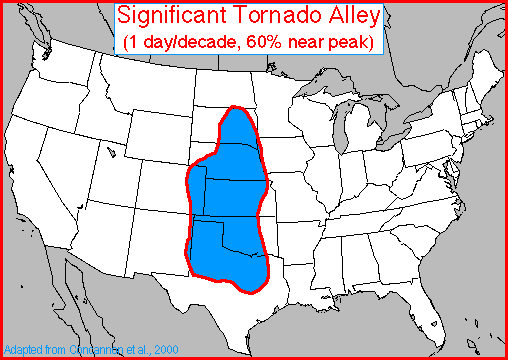
Tornado alley--the region of the country that experiences the greatest number of tornadoes
(Map by Concannon et al. at NOAA)

The salmon- and bright pink-colored areas indicate clay, where it's harder to build basements.
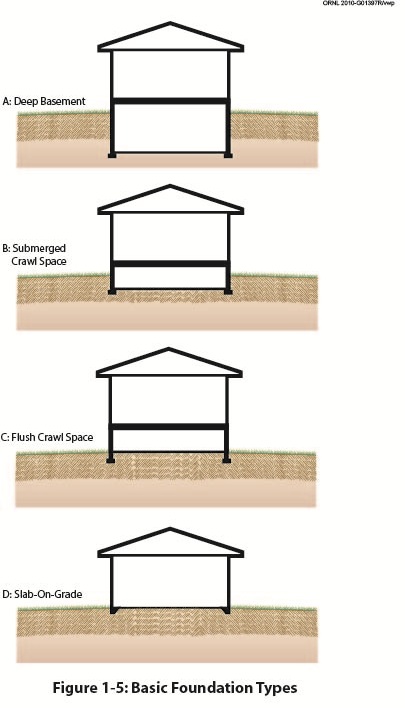
The 4 basic home foundation types. Which one your home has probably depends on whether or not the ground freezes in the winter. Most houses in Oklahoma are of the 4th type: house on top of a slab.
(Diagram from Oak Ridge National Laboratory)
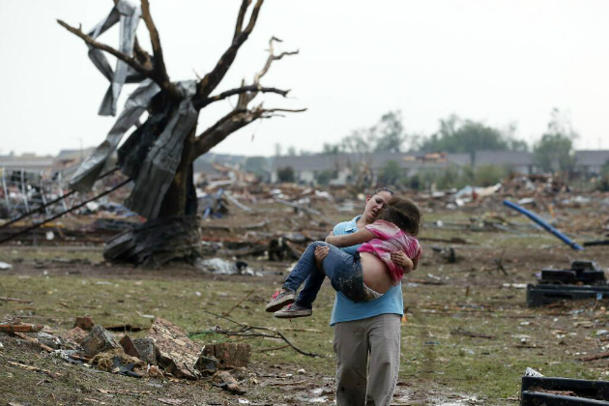
Is this what too-tough-for-basements looks like?
(Photo by Sue Ogrocki/AP)

Maybe this is.
(Photo by B at Complete and Total)

To be sure, digging a basement is no small undertaking. But maybe better to bring out the bulldozers sooner rather than later?
(Photo from Conner Excavating)

Basics of a FEMA-recommended tornado safe room, inside and out.
(Diagram from USA Today)
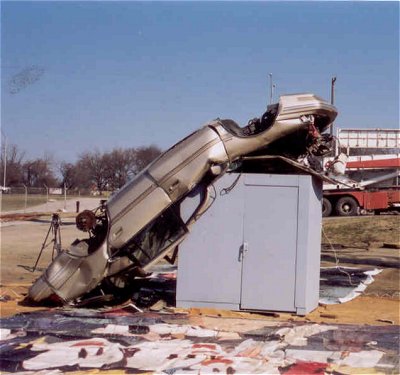
A tornado safe room that did its job well.
(Photo from Abundant Life)

Glenn Lewis, Mayor of Moore, OK. He says they rebuilt their town once before, they can do it again. Maybe this time, they'll build a few basements. Or tornado safe rooms, at least.
(Photo from US Mayors)
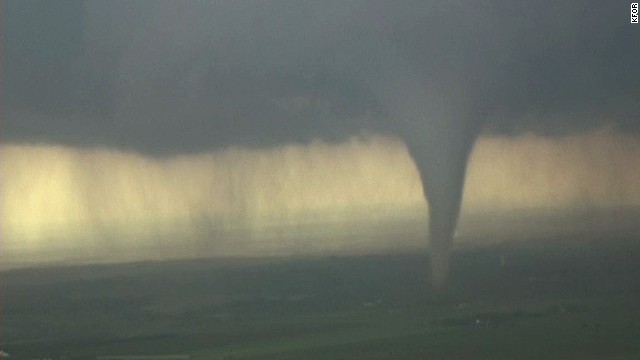
The May 20, 2013 tornado in Moore, OK. It was an unusually big one, but there will probably be others.
(Photo from CNN)
Related Post: Where Does the Debris Go?
Sources
NOAA National Weather Service, Norman, OK, Monthly and Annual Tornado Statistics for the State of Oklahoma, Tornadoes FAQ, Tornado Safety
StateMaster.com, Tornadoes, Total number by state
NewsOK, Oklahoma tornadoes: Cost, custom keep basements scarce, May 25, 2013
Weather.com, Why Don't More Homes in Oklahoma Have Basements? May 21, 2013
Tom Watkins, Basements scarce in tornado-prone Oklahoma City area; here's why, CNN, May 22, 2013
Melissa Block and Scott Neumann, Basements Not An Option For Many Homes In Oklahoma, NPR News, May 22, 2013
John Schwartz, Why No Safe Room to Run To? Cost and Plains Culture, The New York Times, May 21, 2013
DOE ORNL, Foundation Design Handbook
Gibson Homebuilders, Basements in Texas Part 2
Reader's Digest, How to Design a Tornado-Safe Room
National Geographic, Taking Cover: A Guide to Tornado Shelters, 2013
Chad Lawhorn, Oklahoma City tornado sparks discussion of building code standards at Lawrence City Hall, Lawrence Journal-World, May 22, 2013
After the tornado ripped through Moore, Oklahoma at the end of May, my dad said he wondered why houses in Oklahoma don't have basements. I didn't jump on that question right away, so when the disaster faded from the headlines, I thought the topic would no longer be of any interest. But then more tornadoes hit Oklahoma, one of them even tracing the same path as the one that hit Moore in May. That, plus the fact that Oklahoma is practically the tornado capital of the world convinced me that maybe I should do an entry about the absence of basements in Oklahoma after all.

Damage in Moore, OK, following the tornado that hit on May 20, 2013. 24 people were killed and more than 300 injured. An estimated 15,000 homes were destroyed.
(Photo by George Armstrong, FEMA, sourced from Emergency Management)
Tornadoes in Oklahoma
- First, a few statistics about how many tornadoes hit Oklahoma.
- From 1950 through 2012, a total of 3,473 tornadoes have touched down in Oklahoma.
- The average number per year in that 62-year span: 55.
- So far in 2013, there have been 37.
- In 2010, there were 103, with 91 of them happening in May.
- The city that has been hit by the most tornadoes is Oklahoma City. The known total is over 100.
- The only state that has had more tornadoes touch down since 1950 is Texas, with 5,490.

Tornado alley--the region of the country that experiences the greatest number of tornadoes
(Map by Concannon et al. at NOAA)
- There are no guarantees of safety during a tornado, but if a tornado is coming, one of the best places to go is the lowest place possible and stay away from glass. A basement sure fits that bill pretty well.
- But as we all learned when the big tornado hit Moore, there are hardly any basements in Oklahoma. One home buyer posted on a real estate site, "While searching for a house in Oklahoma City area for the past year, I think I found only 3 or so houses with basements."
- Even after the devastating tornado hit Moore in 1999, killing 36 people in Oklahoma and Kansas, only 6 of 40 new homes built had any kind of safe room. None had basements.
- So if your state gets hit by this many tornadoes, and basements are a pretty good safety measure, why don't you build your houses with basements?
- The primary answer: money.
Soil Composition
- The first reason people give for the paucity of tornadoes in Oklahoma is that the soil isn't basement-friendly.
- Oklahoma's soil has high levels of clay, which means it tends to get wet as you dig deeper to make a basement.
- Also, clay doesn't hang onto water very well. In the rainy months, the clay becomes saturated and will rise with water. In the summer when the water dries up and the water table drops, the clay level will drop too.

The salmon- and bright pink-colored areas indicate clay, where it's harder to build basements.
(Map from STATSGO, sourced from the Weather Channel)

Compared to the rest of the US, Oklahoma does have more clay in its soil than other parts of the Midwest and Plains states where tornadoes are common. But you can see that there's even more clay in Texas.
(Map from NASA's Land Data Assimilation Systems)

Cracks in the foundation and the shifting of bricks are two types of damage that can be the result of expansive clay soil.
(Photo by the US Army Corps of Engineers, from geology.com)

Compared to the rest of the US, Oklahoma does have more clay in its soil than other parts of the Midwest and Plains states where tornadoes are common. But you can see that there's even more clay in Texas.
(Map from NASA's Land Data Assimilation Systems)
- Of course the water & clay combination won't rise and fall evenly but will do so all catty-wumpus. And every one of those risings and fallings will put pressure on the walls of a basement foundation. It won't take long before the basement walls crack and let in water or otherwise pretty much fail.
- Building a basement that could withstand the shifting and the expanding and contracting clay soil to keep out water and keep cracks from happening was possible, but expensive. So a lot of builders chose not to dig basements.

Cracks in the foundation and the shifting of bricks are two types of damage that can be the result of expansive clay soil.
(Photo by the US Army Corps of Engineers, from geology.com)
Not Required
- Builders could get away with omitting basements because building codes in Oklahoma didn't require them. In the north, state building codes usually require that homes are built with their foundation based below the frost line. (This also explains why basements are dug to different depths in different parts of the north--it depends how far you have to go to get below the frost line.)
- In the south, because the ground doesn't freeze down there like it does up north, building codes don't require basements. Oklahoma's ground doesn't freeze like it does farther north, so its building codes don't require basements.

The 4 basic home foundation types. Which one your home has probably depends on whether or not the ground freezes in the winter. Most houses in Oklahoma are of the 4th type: house on top of a slab.
(Diagram from Oak Ridge National Laboratory)
- After the big monster-tornadoes of 1999, even though various reports recommended that if homes in Oklahoma were still going to be built on slabs, the slabs should at least be secured with bolts, they're still being built on slabs and secured with the relatively flimsy nails and pins -- because it's cheaper.
- Especially in an economy that has been tough on a lot of middle- to low-income people, nobody wants to add to the cost of a house.
They've Always Done it That Way
- The idea that Oklahoma's soils have too much clay and water, and that therefore a waterproof basement is difficult and expensive to build dates from the 1950s and 1960s when there was a boom in home building. Back then, it was true that it was expensive and difficult to make a basement that would stand up to the rigors of clay soil.
- Since nobody in Oklahoma was willing to pay extra for a basement that would probably leak, nobody built basements. Since there wasn't a market for basements in Oklahoma, contractors who knew how to make them didn't do business in Oklahoma. Since nobody was available to build a basement, even if you wanted one, it could get even more expensive since it was harder to find the expertise and labor.
- So the practice of building homes without basements simply continued.
Again with the Money
- Since few homes in OK have basements, appraisers in the state don't really know how to put a value on a basement. So they tend to omit the basement in their appraisal, which means homeowners who want to sell have a hard time getting back the money they put in to building the basement in the first place.
Too Tough for Basements
- Oklahomans joke that, since they see so many tornadoes, when they hear the sirens go off, instead of taking shelter, they go outside to get a good look. They're kind of proud of this tornado-toughness, maybe to the point of being reluctant to admit they could actually use a safe place to go hide.
- They also tend to dislike being told what to do, especially by some governmental body. You know, that whole independent spirit of the West that is suspicious of the US government trying to dictate people's lives. So they're not very keen to impose a lot of regulations on themselves.

Is this what too-tough-for-basements looks like?
(Photo by Sue Ogrocki/AP)

Maybe this is.
(Photo by B at Complete and Total)
The Truth
- The truth is that "Virtually any foundation type and construction system can be built in any location in the United States" (ORNL)
- OK, sure. But isn't building a basement in Oklahoma too expensive?
- Answer: not anymore.
- Contractors know more about how to deal with clay soils than they used to. One contractor says that floating walls that allow for expansion and contraction are the primary method of building a basement in clay soil.
- Waterproofing methods have also improved, which means that not only is waterproofing more effective but it's also cheaper than it once was.
- In all, one contractor estimates, a small basement would cost around $15,000 to $20,000. A concrete cellar built during new-house construction would cost as little as $2,200. (Cellars are very bare-bones, unfinished, maybe even with a dirt floor. Basements are more finished and waterproofed.)
- Even $20,000 seems like a small price to pay to give your family a place of far better protection than a closet.

To be sure, digging a basement is no small undertaking. But maybe better to bring out the bulldozers sooner rather than later?
(Photo from Conner Excavating)
- Here's more truth for you: above-ground safe rooms can be even better than basements. For one thing, they're much more accessible for people with disabilities.
- A tornado safe room can be built to accommodate any number of people, from 1 to 16.
- The walls are built to withstand winds of up to 250 mile per hour, as well as any flying objects. They're also built without windows, so there's no danger of flying broken glass.
- They should include a first aid and emergency kit with blankets, water, flashlight and batteries, emergency radio, and snacks.

Basics of a FEMA-recommended tornado safe room, inside and out.
(Diagram from USA Today)

A tornado safe room that did its job well.
(Photo from Abundant Life)
- All of those things can be an improvement on a basement, where you may still be vulnerable to high winds and flying objects if your house is torn away from over your head.
- Safe rooms can also be relatively cheap, costing between $2,500 and $5,000 depending on size.
- FEMA has very strict recommendations about how safe rooms should be constructed. So if you're thinking about having one built, definitely consult FEMA's free (but very large) information booklet on how to build a safe room.
- If ADA compliance isn't an issue, FEMA notes, the safest place to put a safe room is -- guess where? In the basement.
- There's also this:
Curtis McCarty, a member of the Oklahoma Uniform Building Code Commission and a builder himself, said the twister on Monday [in Moore, 2013] would have defeated attempts to resist it above ground. “You cannot build a structure that’s going to take a direct hit from a tornado like that that’s going to stand,” he said. (NYT)
The Good News
- Following the 2013 tornado that devastated Moore, the mayor announced that he was going to propose an ordinance that would require new homes to be built with either a reinforced storm shelter or a safe room.

Glenn Lewis, Mayor of Moore, OK. He says they rebuilt their town once before, they can do it again. Maybe this time, they'll build a few basements. Or tornado safe rooms, at least.
(Photo from US Mayors)
- Other towns in Oklahoma are starting to talk about requiring schools and other public buildings to have shelters for people to use during tornadoes.
- A contractor who builds basements and is headquartered in Edmond, Oklahoma recently said in an interview that he has built more than 600 basements in and around Oklahoma City in the past 15 years. He said, "I've got 32 basements to put in the ground right now."
- So nobody seems to be requiring actual basements in Oklahoma -- yet. But some OK communities are starting to talk about requiring some type of shelter. And apparently, a few more homebuilders are building a few more basements here and there, even though they don't have to.
- So maybe in a few years, the news coming out of Oklahoma will be, not about how many people were killed, but rather about how many people survived the sure-to-come wicked-strong tornadoes.

The May 20, 2013 tornado in Moore, OK. It was an unusually big one, but there will probably be others.
(Photo from CNN)
By the Way
- Most homes in Texas don't have basements either.
Related Post: Where Does the Debris Go?
Sources
NOAA National Weather Service, Norman, OK, Monthly and Annual Tornado Statistics for the State of Oklahoma, Tornadoes FAQ, Tornado Safety
StateMaster.com, Tornadoes, Total number by state
NewsOK, Oklahoma tornadoes: Cost, custom keep basements scarce, May 25, 2013
Weather.com, Why Don't More Homes in Oklahoma Have Basements? May 21, 2013
Tom Watkins, Basements scarce in tornado-prone Oklahoma City area; here's why, CNN, May 22, 2013
Melissa Block and Scott Neumann, Basements Not An Option For Many Homes In Oklahoma, NPR News, May 22, 2013
John Schwartz, Why No Safe Room to Run To? Cost and Plains Culture, The New York Times, May 21, 2013
DOE ORNL, Foundation Design Handbook
Gibson Homebuilders, Basements in Texas Part 2
Reader's Digest, How to Design a Tornado-Safe Room
National Geographic, Taking Cover: A Guide to Tornado Shelters, 2013
Chad Lawhorn, Oklahoma City tornado sparks discussion of building code standards at Lawrence City Hall, Lawrence Journal-World, May 22, 2013
Fundamentally, for houses, the storm cellar dividers ordinarily structure the establishment. In hotter atmospheres, a few homes don't have storm cellars since they are redundant. In colder atmospheres, the establishment must be beneath the ice line.
ReplyDelete